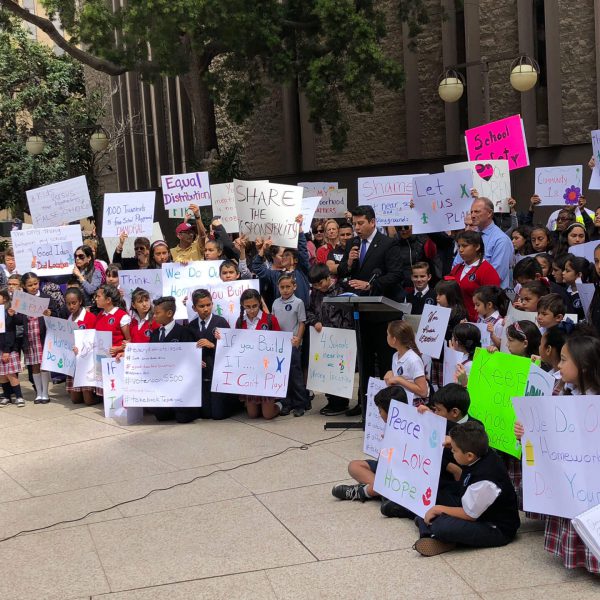SAN DIEGO — In moving public testimony, the students from Our Lady’s School gave the San Diego City Councilmembers a heartbreaking glimpse of what it’s like to live and study in a neighborhood saturated with homeless people and pleaded for them not to add up many more.
At the end, the council voted 8-1 to open a facility to store the belongings of 500 homeless people in a warehouse building just 15 feet from the school in Logan Heights.
The youngsters were part of a contingent of more than 100 students, parents, staff members and pastors from the school who turned out to City Hall on March 20 to speak out against the proposal by Mayor Kevin Faulconer to open the facility in their area.
“I’m afraid someone is going to assault me, or hurt me, or something bad is going to happen to me, and you will never hear from me again,” eighth-grader Emma Vertiz told the council. “It’s like living in a homeless shelter.”
First-grader Richard Cuevas Sisto shared what he has seen on his way to school, which houses kindergarten to third grade.
“When we drive down the street, I see people doing things they should not be doing, like going to the bathroom, throwing trash and using drugs,” said the 7-year-old. “My mom tells me to close my eyes.”
The school’s playground is across a narrow alley from the facility, at 116 S. 20th St. School Principal Noel Bishop told the council that he was forced to close it three years ago because it was not safe to have them there amid the homeless.
This population moved into the area, adjacent to the East Village, in recent years. They congregate and sleep on the narrow sidewalks alongside I-5 within steps of the school. Jesuit Father John Auther, pastor of Our Lady of Guadalupe Parish, noted that the outbreak of Hepatitis A last fall had enabled city authorities to clear out many of them and to clean up the area.
In the last four months, however, the city opened two shelters in the neighborhood to provide temporary housing for the homeless. The one on 16th Street and Newton Avenue houses up to 350 men and women and the one at 14th and Commercial Street up to 150.
The principal and students told the council that the school was not against the homeless. Indeed, the Catholic Church dedicates significant resources to helping this population. And at the school, the students do service projects to help them.
The principal said the school opposed the location and the lack of opportunity for the community to give input on the plan.
Before the vote, council members agreed to reduce the number of people the facility would serve from 1,000 to 500, to open it after school lets out in June, to keep the area clean and to beef up security.
Father John expressed doubts that the city could make good on these promises, given his years-long experience with the conditions around his parish. Both he and the principal expressed pride that their students had stepped up to advocate for their school.
“Generally, you send students on a field trip to see how democracy works,” Father John said. “These kids went to make democracy work.”
The Southern Cross




